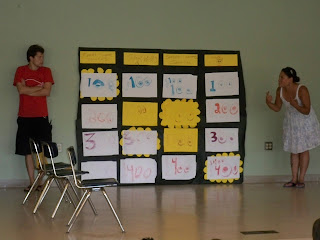At Children’s Choice, one of the outcomes we are trying to
achieve with kids is that they develop skills for managing stress, coping with
feelings, and being resilient when bad things happen in life. How do we do this?
1. Power of Play
We make time for play. Play is not
a four-letter word. Well, actually it is, but that’s not the point. Play is not
a frill. It is a powerful tool for managing stress. Play gets the brain to
release powerful neurotransmitters like dopamine and serotonin that counteract
stress. Play creates a sense of
belonging and fosters cooperation. Play supports social, intellectual, and
language development. Play builds confidence, and relieves stress. So, we bring
“FUNERGY” to the job!

2. Confidence through Enrichment
Confidence is a skill that is a necessary
building block for developing self-control and the ability to solve stressful problems.
Often, kids who are struggling in traditional school subjects suffer from a
lack of confidence, which inhibits their ability to solve problems and
increases stress in difficult situations. When children have the opportunity to
be involved in activities like drama, team-building, music, cooking, sports,
gardening, dance, and art, they learn that there are many things they might be
good at in addition to the more traditional school subjects. Through these
experiences they gain the ability to approach challenges with more confidence.

3. Role Models who Fail
Adults make mistakes. Sometimes
adults hide this fact from children or blame others when they make a mistake.
At CC, we are trained in the value of recognizing mistakes, admitting mistakes,
and learning from mistakes. When we make a mistake, we acknowledge the mistake so
the kids can hear us saying, “Oops” or “My bad.” Then we come up with a
strategy to fix our problems, and talk about the lessons we learned. We very
intentionally do all of this out loud, so children can hear how responsible
adults handle it when we make mistakes.
4. Permission to Make Mistakes
We give kids permission to make
mistakes. Mistakes are part of
life, and are valuable to the learning process. Some of the strongest learning
moments happen when people make mistakes.
When kids make mistakes, staff don’t shame them, or punish them. We say,
“That’s okay, try it again.” We say, “hit the reset button and try a different
solution.”
5. Name that Feeling
We help children identify feelings by labeling or naming the emotion out loud. “I see that your face is red and you are breathing very fast. It looks like you are angry. What’s happening?” or “I can tell you are upset right now. You look very sad. Would you like to talk about it?”
6. Listen, just listen.
When we do get kids to open up and
talk to us, we don’t interrupt. We let them finish. We don’t “make them wrong”
or disagree, especially when they are talking about their feelings. You won’t
hear our staff say, “You shouldn’t get angry about that” or “That is not
something to get upset about.”
7. Acknowledge Super Powers
We don’t attempt to control kids.
Instead we help them develop what psychologists call an Inner Locus of Control. We teach kids to recognize their feelings,
and to understand that feelings are not good or bad, but that they have control
over their actions and how they behave when they feel a certain way. When kids
say things like, “Ryan made me hit him,” we challenge this by asking “Would it
be more accurate to say, you felt
angry and chose to hit Ryan?”
We intentionally teach children these steps to coping when bad stuff happens.
Help them C.O.P.E.
8. C = Calm.
This is all about arousal control.
We teach them breathing techniques like taking a series of slow breaths in
through their nose and even slower breaths out through their mouth. We teach
them progressive muscle relaxation exercises like first tensing and then
relaxing their muscles starting at their toes and ending with the muscles in
their faces.
9. O = Options.
We encourage them to stop, take a
breath, and relax before reacting to the situation. We know the longer they
delay before reacting, the longer of a list of options they can create. The
more options they can create, the more likely they are to come up with an
effective and appropriate response. , Frontal Lobe takes the keys, Self Talk,
Break it Down, Generate Long Lists, Brainstorm, Visualization and Mental
Rehearsal Making a long list of strategies,
10. P = Problem Solving
The next step is picking a
strategy and putting one into practice.
Try it out and see if it works. We teach them to acknowledge that the
situation stinks, to acknowledge how they feel about it, make a list of
possible solutions, then pick one. One of our useful phrases is, “That stinks,
now… what can we do to MAKE THE BEST OF IT?”
11. E = Evaluate
After picking a problem-solving
strategy and trying it out, look back and see if it worked. We ask, “Did that
work?” “What part didn’t work so
well?” “If you could go back and try it again, what strategy do you think you
might pick this time?”


















